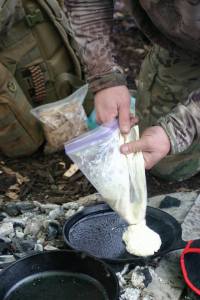
While the focus is on us as humans, don’t forget your trail buddy or gun dog can be impacted as well so don’t let them drink from streams. Dogs effected by Giardia will suffer, not perform as well as they should, and can run up a pretty high vet bill getting rid of tummy issues associated with water.
In 1989 I was out on an extended hike/ survival skills test with my friend and mentor Gary. We had both run out of water and it was a rare heat wave in Germany. We sat up a temporary sit-spot by the Kyll River, which is a tributary of the Moselle. We were close to the head waters of it, but you first need to understand what flows into the Kyll.
Germany has a vast amount of space in the Rhineland-Pfalz area dedicated to dairy farming. Every morning cattle leave their stables and walk to the fields where they graze. These fields drain into the river.It not only contains the output of the cattle, but in the late fall and early spring the fields are furtilized. Cow excrement from the stables is collected into a vat, pumped into a “honey wagon” and then towed to the field by a tractor and sprayed onto the fields.
At this point you have probably realized that one of us decided to bypass the pufification part of this little adventure and I can guarantee, it wasn’t me. Gary learned two important lessons that day, the first to always purify water and the second is the value of the extra TP I packed.
In a survival situation things already suck, so don’t make them worse. By drinking non-potable water (water unsafe for drinking) you may contract diseases or swallow organisms that can harm you. Examples of such diseases or organisms include but are not limited to:
Dysentery- Severe, prolonged diarrhea with bloody stools, fever, and weakness.
Cholera and Typhoid- You may be susceptible to these diseases regardless of inoculations.
Flukes- Not a huge issue in Idaho survival situations. Stagnant, polluted water–especially in tropical areas–often contains blood flukes. If you swallow flukes, they will bore into the bloodstream, live as parasites, and cause disease.
Leeches- If you swallow a leech, it can hook onto the throat passage or inside the nose. It will suck blood, create a wound, and move to another area. Each bleeding wound may become infected. This just has suck (no pun intended) all around it.
Giardia- A common threat in the back country, Giardia lives inside intestines of infected humans, cattle, sheep, or other animals (wild or domestic). Individuals become infected through ingesting or coming into contact with contaminated food, soil, or water. This means that washing dishes in the creek or dipping your canteen in a pond can put you at risk if you don’t sanitize all surfaces that come in contact.
Cryptosporidium- You don’t just have to ingest water, but swimming in water that is contaminated is also dangerous. This is a microscopic parasite that causes the diarrheal disease cryptosporidiosis. Both the parasite and the disease are commonly known as “Crypto.”
The parasite is protected by an outer shell that allows it to survive outside the body for long periods of time and makes it very tolerant to chlorine disinfection.
While this parasite can be spread in several different ways, water (drinking water and recreational water) is the most common method of transmission. Cryptosporidium is one of the most frequent causes of waterborne disease among humans in the United States.
Drinking unsafe water can make your survival situation worse and once rescued can prolong recovery and in some cases cause long-term effects and possibly death.

























